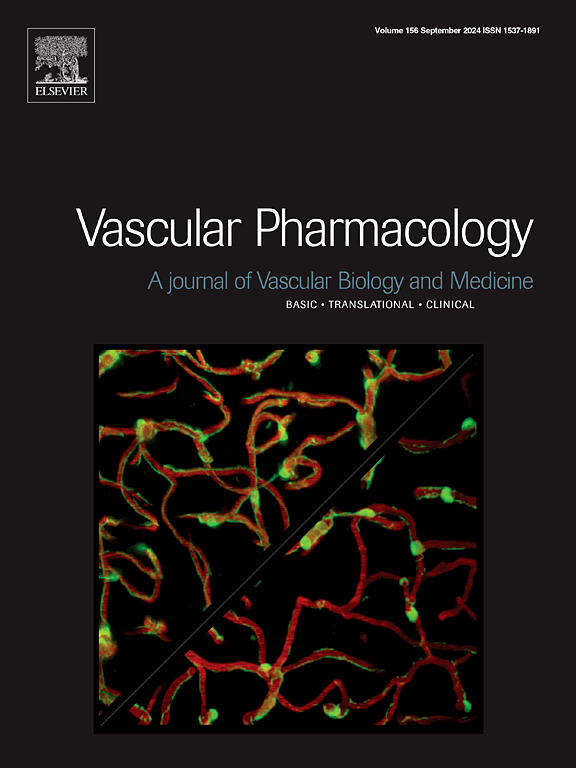长期暴露于 L-NAME 会使人体动脉血管中的血管扩张因子从 NO 转变为 H2O2,从而对 A23187 产生反应。
IF 3.5
3区 医学
Q2 PHARMACOLOGY & PHARMACY
引用次数: 0
摘要
钙离子拮抗剂 A23187 可诱导内皮依赖性和非受体介导的人体脂肪动脉(HAA)血管扩张。本研究旨在确定 A23187 诱导冠状动脉疾病(CAD)患者和非冠状动脉疾病(CAD)患者 HAAs 血管扩张的机制。研究人员从非冠心病患者(25 人)和冠心病患者(14 人)的脂肪组织中新鲜分离出 HAAs,并通过视频显微镜研究其血管反应性。非 CAD 和 CAD 受试者对 A23187 的基线剂量反应没有差异。然而,NO 合酶抑制剂 N(ω)-硝基-精氨酸甲酯(L-NAME)的急性孵育(30 分钟)强烈减少了 A23187 在非 CAD 动脉中诱导的扩张,而 H2O2 清除剂过氧化氢酶则在很大程度上消除了 CAD 患者的扩张。令人惊讶的是,L-NAME 长时间(90 分钟)孵育可恢复非 CAD 受试者的 A23187 反应,随后过氧化氢酶可抑制这种反应。长时间暴露于 L-NAME 的作用在用 Krebs 冲洗后不可逆,而急性暴露于 L-NAME 的作用在很大程度上是可逆的。为了进一步确定线粒体衍生的 ROS 在 A23187 诱导的扩张中的作用,用鱼藤酮(电子传递链复合物 I 的抑制剂)处理动脉血管。罗替农能消除 CAD 患者和非 CAD 动脉血管在长时间 L-NAME 作用下对 A23187 的反应,但非 CAD 对照组的反应则不明显。这些数据表明,在非 CAD 患者的 HAA 中,NO 对 A23187 诱导的扩张做出了贡献,而在 CAD 患者中,H2O2 对扩张做出了贡献。在非 CAD 受试者中,长期暴露于 L-NAME 会诱导扩张机制中的 NO-H2O2 转换。此外,长期暴露于 L-NAME 的影响不易逆转,而急性暴露于 L-NAME 的作用是可逆的。本文章由计算机程序翻译,如有差异,请以英文原文为准。

Prolonged L-NAME exposure changes the vasodilator factor from NO to H2O2 in human arterioles in response to A23187
The Ca2+ ionophore A23187 induces endothelium-dependent and non-receptor-mediated vasodilation in human adipose arterioles (HAAs). The purpose of this study was to determine the mechanism of A23187-induced dilation in HAAs from patients with and without coronary artery disease (CAD). HAAs were freshly isolated from adipose tissues obtained from non-CAD (n = 25) and CAD (n = 14) patients, and vascular reactivity was studied by videomicroscopy. No difference in baseline dose response to A23187 was observed between non-CAD and CAD subjects. However, acute (30 min) incubation with N(omega)-nitro-l-arginine methyl ester (L-NAME), NO synthase inhibitor strongly reduced A23187-induced dilation in non-CAD arterioles, while catalase, an H2O2 scavenger, largely abolished dilation in CAD. Surprising, prolonged (90 min) incubation with L-NAME restored A23187 response in non-CAD subjects, which was subsequently inhibited by catalase. The action of prolonged L-NAME exposure was not reversible after washing with Krebs while the effect of acute L-NAME exposure was largely reversible. To further determine the role of mitochondria-derived ROS in A23187-induced dilation, arterioles were treated with rotenone, an inhibitor of complex I of the electron transport chain. Rotenone abolished A23187 response in CAD patients and in non-CAD arterioles after prolonged L-NAME, but not in non-CAD controls. These data indicate that NO contributes to A23187-induced dilation in HAAs from non-CAD patients and H2O2 contributes to the dilation in CAD patients. Prolonged L-NAME exposure induces a NO-H2O2 switch in the mechanism of dilation in non-CAD subjects. Moreover, the effect of prolonged L-NAME exposure is not readily reversible, while the action of acute L-NAME exposure is reversible.
求助全文
通过发布文献求助,成功后即可免费获取论文全文。
去求助
来源期刊

Vascular pharmacology
医学-药学
CiteScore
6.60
自引率
2.50%
发文量
153
审稿时长
31 days
期刊介绍:
Vascular Pharmacology publishes papers, which contains results of all aspects of biology and pharmacology of the vascular system.
Papers are encouraged in basic, translational and clinical aspects of Vascular Biology and Pharmacology, utilizing approaches ranging from molecular biology to integrative physiology. All papers are in English.
The Journal publishes review articles which include vascular aspects of thrombosis, inflammation, cell signalling, atherosclerosis, and lipid metabolism.
 求助内容:
求助内容: 应助结果提醒方式:
应助结果提醒方式:


